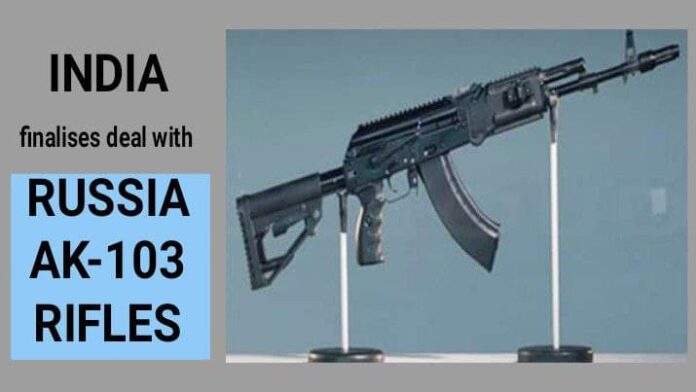India and Russia Sign deal for the procurement of sizeable number of AK-103 series for the Indian Army under the provision of emergency financial powers granted to the services to make urgent purchases.
- This deal is on the lines of the mega infantry modernisation programme by the Indian Army for the replacement of its ageing and obsolete weapons with a large number of light machine guns, battle carbines and assault rifles.
- No specifications of the rifles has been provided.
Background
In October 2017, the Indian Army began the process to acquire around 7 lakh rifles, 44,000 light machine guns (LMGs) and nearly 44,600 carbines to further enhance the combat capability of the Army.
Points to be noted:
- In September 2020, Ministry of Defence and Russian representative inked a major deal for manufacturing ~6 lakh AK -47 203 rifles in India under Make in India programme. These will be manufactured by the Indo Russia Rifles Pvt. Ltd, a joint venture between the Ordnance Factory Board (OFB) , the Kalashnikov concern ( manufaturer of the AK rifles ) and Rosoboronexport, the Russian state agency for military exports.
- The AK-47 203 is the lastest and the most advanced verison of AK-47 , which will replace the Indian Small Arms System ( INSAS ) 5.56x45mm assault rifle that are currently in use with the Army, Navy and the Air Force.
The Ministry of Defence has already floated a Request For Proposal (RFP) to the JV for the supply of 6.71 lakh rifles but the final deal has been held up over the high cost quoted.
In the Ka-226T helicopter, there are two major changes which include change in hull from composites to aluminum and change in avionics apart from several minor upgrades, said Vasily Grydin, deputy head of commercial department, Ulan-Ude Aviation plant of Russian Helicopters at the Army 2021 expo which began on Sunday.
“Major upgrades were done in the hull and the avionics to make the helicopter lighter and improve its capability. Some of the modifications were done based on the request of the customer (India),” Mr. Grydin said. These changes were done in the last one year while talks continue between the two sides for the final deal, he stated.
There is an upgrade in avionics and there is an option where the helicopter can be operated by one pilot if required, Mr. Grydin explained.
On the change in the hull, he said it was made stronger by using aluminum in the place of composites which was done for the sake of the exhaust and the helicopter has become 15% lighter. Dust filters have also been introduced for the purpose of high altitude operations while the fuel tank has also been redesigned.
Another major change is improved design of gear box which can work twice longer, he added.
In 2015, India and Russia had concluded an Inter-Governmental Agreement (IGA) for at least 200 Ka-226T twin-engine utility helicopters estimated to cost over $1 billion.
Sixty helicopters were to be directly imported and remaining 140 manufactured locally by a JV, India Russia Helicopters Limited, set up between Hindustan Aeronautics Limited and Russian Helicopters.
However, the deal has been held up over the percentage of indigenous content which as per the RFP should reach 70% in phases. Due to this, the Army, which is in urgent need of replacing the ageing Cheetah and Chetak helicopters, has approached Defence Ministry to procure a limited number of helicopters immediately.
As per the Russian proposal, the localisation plan would be spread over four phases beginning with 3.3% indigenisation for 35 helicopters, going to 15% for next 25 helicopters, 35% for 30 helicopters in Phase 3 and eventually to 62.4% indigenisation in Phase 4 for the last 50 helicopters.
The first helicopter would be delivered within 36 months from the signing of the contract and order completed in eight years.










